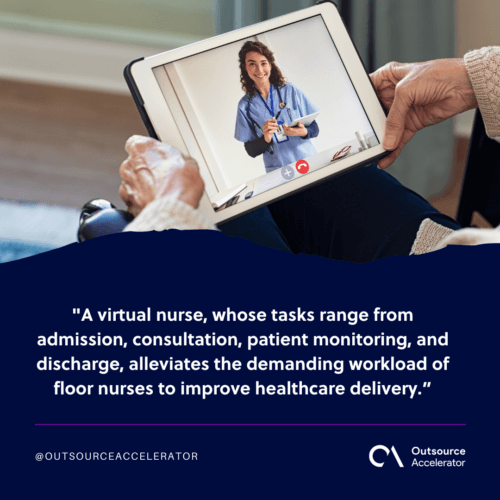Rise of the virtual nurse
Before, the only screens in hospitals were monitors showing heart rates and vital signs. Nowadays, there is a screen with a human face: the virtual nurse who’s sitting somewhere else, helping with the workload.
This is how health systems have been keeping up with the severe healthcare workforce shortage. A virtual nurse, whose tasks range from admission, consultation, patient monitoring, and discharge, alleviates the demanding workload of floor nurses to improve healthcare delivery.
While virtual nurses might not be able to contribute physically, there are a lot of things they can do. Not least, the growing mountains of reporting and documentaiotn. Equally, virtual nursing allows older, less able nurses to contribute long after their physical prime.

The right ratios
Hospitals have integrated virtual nurses into their day-to-day operations, and it’s working well. One hospital opts for three-person teams: one virtual and two on-site — finding this provides optimal productivity enhancement for the two onsite staff.
Some hospitals are more varied in their virtual-to-floor ratio, depending on the patient’s needs. It’s not unusual for one patient to receive blended care from a registered nurse, a nursing assistant, and a virtual nurse who’s registered on-site.
Meanwhile, other hospitals have implemented a system that utilizes artificial technology. The floor nurse looks after the patient, the virtual nurse takes care of administrative tasks, and the room is augmented with AI sensors that keep an eye on the patient, and reduce nursing burden.
Determining the floor-to-virtual nurse ratio is important to avoid redundancies and maximize productivity. However, the ratio should not be etched in stone. Hospital systems should always look to tweak it depending on patient inflow and their corresponding needs.
Rebuilding workflows
Hospitals have found that getting the right ratios is not the only part of the puzzle. They have had to adapt existing processes to incorporate the new virtual workforce. The status quo had to change, separating activities that ‘had to’ be done onsite, versus those that could be done remotely. Equally, the health systems have to establish that virtual nurses are an intrinsic part of the team and not just some add-on.
Lessons for us all
As the adage goes, necessity is the mother of invention. Hospitals have figured out the solution to their severe staff shortage issue. The infinitely complex healthcare system has created a pathway forward, maybe other businesses should also take note.
For medical firms, success means accommodating the continuous surge of patient care. For businesses, progress means remaining profitable amid the rapid changes in the economy.
A globalized economy provides businesses with easy access to high-quality staff for a fraction of the cost. Virtual staff and AI have become lifelines for the medical industry and are something that other industries can also adopt, benefit from, and out-complete their competition.

Question for your business
Are you revisiting your workflows and optimizing for offshore, remote, and AI solutions?

 Independent
Independent





















